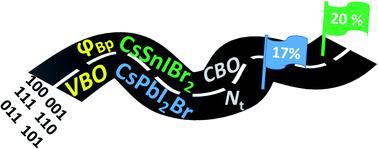当前位置:
X-MOL 学术
›
Sustain. Energy Fuels
›
论文详情
Our official English website, www.x-mol.net, welcomes your
feedback! (Note: you will need to create a separate account there.)
Unravelling the theoretical window to fabricate high performance inorganic perovskite solar cells
Sustainable Energy & Fuels ( IF 5.0 ) Pub Date : 2020-11-4 , DOI: 10.1039/d0se01160f Yassine Raoui 1, 2, 3, 4, 5 , Hamid Ez-Zahraouy 5, 6, 7, 8 , Shahzada Ahmad 1, 2, 3, 4, 9 , Samrana Kazim 1, 2, 3, 4, 9
Sustainable Energy & Fuels ( IF 5.0 ) Pub Date : 2020-11-4 , DOI: 10.1039/d0se01160f Yassine Raoui 1, 2, 3, 4, 5 , Hamid Ez-Zahraouy 5, 6, 7, 8 , Shahzada Ahmad 1, 2, 3, 4, 9 , Samrana Kazim 1, 2, 3, 4, 9
Affiliation

|
Perovskite solar cells (PSCs) have experienced a decade of intense investigation as a promising photovoltaic technology, having a power conversion efficiency of 25.5% with the use of lead based light harvesters. Recently, inorganic cesium cation based mixed halide perovskites (CsMI3−xBrx, M = Pb or Sn) as absorbers in PSCs gave promising results; in particular CsPbI2Br demonstrated improved thermal stability and carrier transport properties. However, the performance is far-off from the theoretical limit due to intriguing issues such as high defect density (Nt) and energy level mismatch. Such barriers can be overcome through device modelling and unraveling the kinetics. Here we have employed a computational approach to design and investigate CsPbI2Br based solar cells by elucidating the role of defect density in the performance and further different types of hole transport layers via optimizing their valence band offset and the barrier height at the back contact was also probed. By optimizing such parameters for CsPbI2Br, power conversion efficiencies of 17.71, 17.44 and 17.54% using CuSCN, PTAA and spiro-OMeTAD as hole selective layers respectively can be reached. Furthermore, lead free CsSnI3−xBrx (0 < x < 3) based PSCs were simulated and the effect of band gap variation as a result of the Br content was studied on the performance. The influence of the defect density of the absorber layer (CsSnIBr2) at interfaces was studied, and with optimized defect density CsSnIBr2 based PSCs gave an efficiency of 20.32% with a Voc of 1.35 V when SnO2 was used as the electron transport layer and spiro-OMeTAD as the HTM. Our approach suggests ways for experimental design protocols to achieve high performance inorganic Pb and Sn based PSCs.
中文翻译:

揭开制造高性能无机钙钛矿太阳能电池的理论窗口
钙钛矿太阳能电池(PSC)作为有前途的光伏技术已经历了十年的深入研究,使用铅基集光器的功率转换效率为25.5%。最近,无机铯阳离子基混合卤化物钙钛矿(CsMI 3- x Br x,M = Pb或Sn)作为PSC的吸收剂产生了可喜的结果。特别是CsPbI 2 Br表现出改善的热稳定性和载流子传输性能。然而,由于诸如高缺陷密度(N t)和能量水平不匹配。这些障碍可以通过设备建模和揭示动力学来克服。在这里,我们通过一种计算方法来设计和研究基于CsPbI 2 Br的太阳能电池,方法是通过优化其价带偏移和背面接触的势垒高度来阐明缺陷密度在性能以及其他不同类型的空穴传输层中的作用。也进行了调查。通过针对CsPbI 2 Br优化此类参数,分别使用CuSCN,PTAA和spiro-OMeTAD作为空穴选择层,可以实现17.71%,17.44%和17.54%的功率转换效率。此外,无铅CsSnI 3− x Br x(0 < x<3)模拟了基于PSC的PSC,并研究了由于Br含量引起的带隙变化对性能的影响。研究了吸收层(CsSnIBr 2)在界面处的缺陷密度的影响,并通过优化缺陷密度,将SnO 2用作电子传输体时,基于CsSnIBr 2的PSC的效率为20.32%,V oc为1.35 V层和spiro-OMeTAD作为HTM。我们的方法为实验设计方案提出了实现高性能基于无机Pb和Sn的PSC的方法。
更新日期:2020-12-17
中文翻译:

揭开制造高性能无机钙钛矿太阳能电池的理论窗口
钙钛矿太阳能电池(PSC)作为有前途的光伏技术已经历了十年的深入研究,使用铅基集光器的功率转换效率为25.5%。最近,无机铯阳离子基混合卤化物钙钛矿(CsMI 3- x Br x,M = Pb或Sn)作为PSC的吸收剂产生了可喜的结果。特别是CsPbI 2 Br表现出改善的热稳定性和载流子传输性能。然而,由于诸如高缺陷密度(N t)和能量水平不匹配。这些障碍可以通过设备建模和揭示动力学来克服。在这里,我们通过一种计算方法来设计和研究基于CsPbI 2 Br的太阳能电池,方法是通过优化其价带偏移和背面接触的势垒高度来阐明缺陷密度在性能以及其他不同类型的空穴传输层中的作用。也进行了调查。通过针对CsPbI 2 Br优化此类参数,分别使用CuSCN,PTAA和spiro-OMeTAD作为空穴选择层,可以实现17.71%,17.44%和17.54%的功率转换效率。此外,无铅CsSnI 3− x Br x(0 < x<3)模拟了基于PSC的PSC,并研究了由于Br含量引起的带隙变化对性能的影响。研究了吸收层(CsSnIBr 2)在界面处的缺陷密度的影响,并通过优化缺陷密度,将SnO 2用作电子传输体时,基于CsSnIBr 2的PSC的效率为20.32%,V oc为1.35 V层和spiro-OMeTAD作为HTM。我们的方法为实验设计方案提出了实现高性能基于无机Pb和Sn的PSC的方法。











































 京公网安备 11010802027423号
京公网安备 11010802027423号